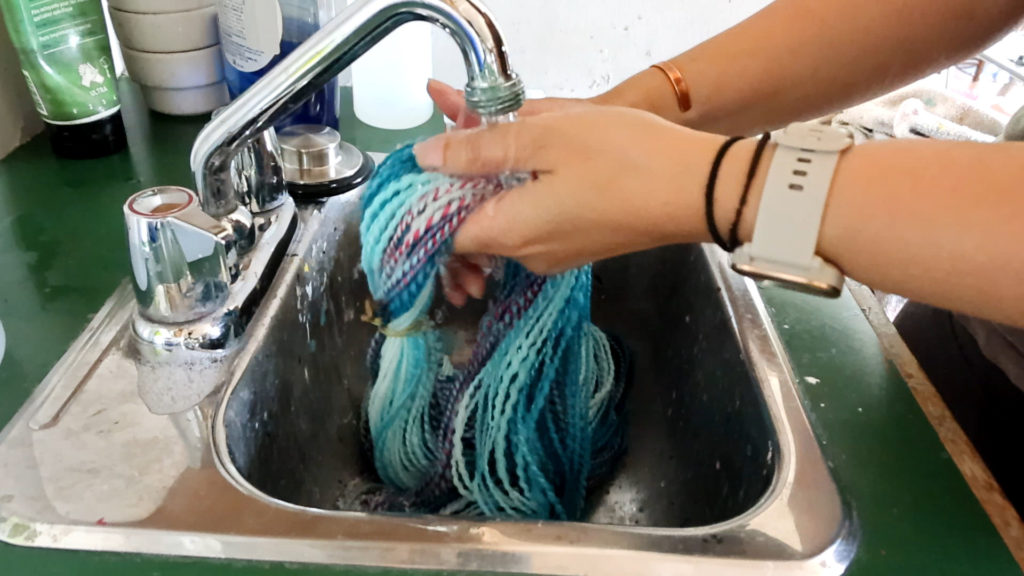Setting Your Handspun Yarn is Just a Snap (or two, or three!) Away
Thus far, I’ve shared two variations on setting the twist of handspun yarn made with wool: wet-setting handspun yarn with thwacking and steam-setting handspun yarn. Today, I share the third and final way I set handspun. I call it snap setting, but I don’t know if that’s the official name.
It’s a type of wet setting, but instead of thwacking, you do a quick snap between your hands. I like this technique for yarn that is already pretty balanced and just needs a bit of encouragement to fall in line. (haha!)
Let’s face it: thwacking is therapy. 😉 It will always be my favorite way of setting handspun wool yarns. But snap setting is the perfect fast way to get the job done and get on with the day.
A Word of Caution
These techniques are my tried-and-true methods for setting the twist of wool yarns. I have not tested them thoroughly on vegetable fibers because I haven’t made a lot of yarn out of those types of fibers. Silk should not be thwacked (I learned this the hard way), and I doubt snap setting would be compatible either. Silk inclusions in wool yarns are just fine in my experience; it’s just not a good idea for 100% silk yarn. It loses its lustre.
How to Snap Set Handspun Yarn
To Soak or Not to Soak
It’s customary to soak handspun yarn in warm to hot water as part of the setting process. I typically soak larger skeins of yarn or if they need a light cleaning.
For example, unless it’s filthy, I prefer to spin Alpaca fleece and wash it after the yarn is completed. The same goes for yarn I suspect might contain dye that will run (like red can do). But a simple rinse under hot tap water with a few pumps of TNA Soap (or Synthrapol or Blue Dawn dish detergent) does the trick for a small skein like this. It’s a resourceful and clever method that saves time and effort.

I’m also usually doing several things at once, and the thought of soaking all these small skeins of yarn…well, what ends up happening is that they hang in the studio unset for months! So, this rapid method motivates me to move that yarn into the finished pile. In my opinion, it works just as well. I appreciate the time savings.
Water Conservation
Water conservation would be another reason to soak versus quickly wetting under the tap. We have a very deep well with lots of water at our disposal, not metered municipal water, so I can use water to my heart’s content. However, I’m still mindful of how much water I’m using. Running such a small skein under the tap will have a minimal impact on our water supply.
If water use is a concern, I recommend soaking several skeins at once in the sink. Tie them together so that they don’t become entangled.
Snap Setting
After your skein is well-soaked and you have gently squeezed out as much water as possible, it’s time to do the snap setting. Hold the yarn in both hands at either end of the skein, gently gripping inside the skein (think of a donut and gripping each side, or how you would tie off a skein at both ends).
Then, move your hands apart quickly, giving the yarn a good snap. Do this three or four times, preferably moving your hands to different positions on the skein so that most areas get a snap. You can see an example of what I mean in the video above.
This only takes seconds to do, and then you can hang it up to dry. Outside in the sunshine is always a nice choice, but if you must hang it indoors, choose a well-ventilated area and place a towel or pan underneath to catch any drips. You could gently squeeze out the water with a towel or cloth when you see it dripping.
Setting the twist of handspun yarn can be daunting, especially if we want to hurry up and use it! I hope this technique allows you to set yarn quickly and easily, especially if you get on a spinning tangent and the skeins are backing up. 😉
Until next time…


